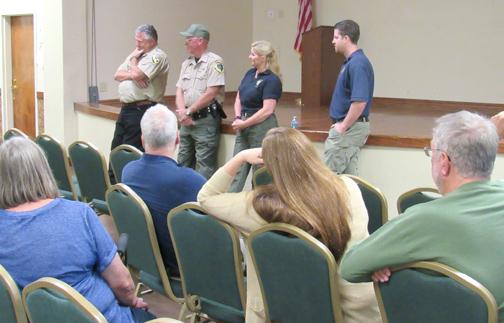
Members of the GPD, with Andrew Hughan and Marty Wall from California Fish and Wildlife and biologists, listen to concerns from local residents who have encountered bears in their neighborhoods.
By Dylan SYLVESTER
The proliferation of wildlife visits to local neighborhoods, including those by the California black bear, was the focus of a recent meeting hosted by the Glendale Police Dept.
It was four years ago that repeated visits to the community by Meatball the bear reminded residents how close they were to wildlife. Since Meatball’s visits, and subsequent relocation to a wildlife sanctuary in Alpine, California, other bears have made their way down from the Angeles National Forest. Whether due to lack of water or food, their presence has raised concerns within the Glendale Police Dept. The GPD invited the public to an informational meeting regarding bear sightings, maintenance and safety on Sept. 22 at the Sparr Heights Community Center.
Andrew Hughan and Marty Wall from California Fish and Wildlife, accompanied by two biologists, joined GPD. Hughan was involved with Meatball since the first sighting until his relocation to the San Diego bear sanctuary.
“I go down there once a year and visit him,” Hughan said.
The meeting began by addressing the fears voiced by audience members regarding their safety. Hughan said that although some species of bears, such as grizzlies, can be aggressive black bears, which are native to California, are normally not.
“They’re practically scared of their own shadow,” he said.
The experts shared precautions that can be taken to be “bear aware” including securing trash bins and making sure to clean yards of items such as fallen fruit. They added that commodities such as bird feeders could be enough to draw bears to a home and said that natural plants and flowers could replace feeders to bring birds to homes without attracting bears.
The Fish and Wildlife officers have at times run into opposition to their peaceful approach. In one instance residents in the hills of Pasadena have started petitions to request Fish and Wildlife to find and kill bears that continue to come into their neighborhood. This is never the goal of Fish and Wildlife, Hughan said. The agency’s aim is to educate community members who have homes near wildlife areas.
One couple at the seminar shared their story of bear visits. La Crescenta residents Kate and Rod Bearden have had two bears intrude their home on multiple occasions. The bruins have taken down the fence in the Beardens’ yard and even broke their basement door. At the meeting, the couple approached the presenters hoping for some advice in order to come to a passive conclusion.
The couple was told wildlife was becoming more and more a part of residents’ lives and that the community, surrounded by mountains, shared their neighborhoods with bears and other wildlife.
“If you leave with anything tonight,” Hughan said, “[it is] don’t help wildlife.”
He told people not to offer or leave food out for wild animals, that it teaches them to return to that area and actually endangers them by taking away their natural ability to find food in the wild.
One thing was made clear—bears are here to stay in Southern California in general and in Crescenta Valley specifically. Through education, it is hoped residents can find a way to co-exist peacefully with wildlife.
Mary O’Keefe contributed to this story.
